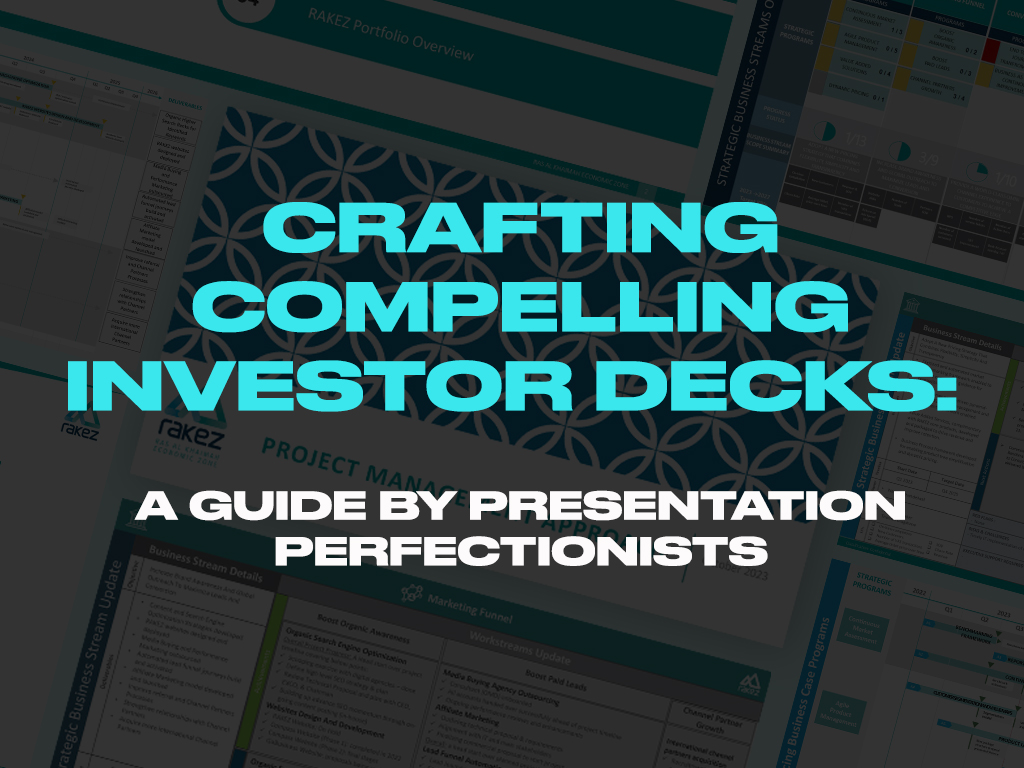Creating a standout investor pitch deck can be a tough task. Many entrepreneurs struggle to present their ideas in a way that captivates and convinces potential investors. The challenge lies in distilling complex concepts into a concise and compelling narrative that resonates with your audience.
Fortunately, there’s a structured approach to creating a pitch deck that not only grabs attention but also delivers your message effectively. By focusing on key elements and utilizing best practices, you can develop a pitch deck that showcases your vision and business potential with clarity and impact.
Understanding the Investor Pitch Deck
When seeking investment, a well-crafted pitch deck is essential for capturing the interest of potential investors. This document serves as a visual and narrative tool that outlines your business idea, its value proposition, and its potential for growth. Understanding the nuances of what makes an effective pitch deck can significantly enhance your chances of securing funding.
What is an Investor Pitch Deck?
An investor pitch deck is a concise presentation, typically consisting of 10-15 slides, designed to provide investors with a snapshot of your business. It covers the core elements of your business model, including the problem you’re solving, your solution, market opportunity, and financial projections. This document is not just a summary but a persuasive tool aimed at showcasing your startup’s potential and encouraging investors to take the next step.
Difference Between a Pitch Deck and an Investor Deck
While the terms “pitch deck” and “investor deck” are often used interchangeably, they can have subtle distinctions. A pitch deck is generally used during initial meetings with potential investors to generate interest and secure follow-up meetings. It focuses on high-level aspects of the business to make a strong first impression. On the other hand, an investor deck might be more detailed and tailored for in-depth discussions with interested parties. It often includes comprehensive financials and operational details that provide a deeper insight into the business for investors who are closer to making a funding decision.

Key Components for an Effective Pitch Deck
Creating an effective pitch deck involves including several crucial elements that collectively tell the story of your business. Each section should be carefully crafted to highlight key aspects of your venture, providing potential investors with a clear and compelling understanding of your startup’s value and potential.
1. Executive Summary
Overview of the Business
The executive summary is the first impression your pitch deck will make. It provides a snapshot of your business, summarizing your mission, vision, and overarching goals. This section should quickly convey the essence of your startup, making it clear what your business is about and why it matters.
Key Value Proposition
Following the overview, the key value proposition outlines what makes your business unique. It addresses why your product or service stands out in the market and how it delivers value to customers. This part should capture the core benefit that your business offers and why it is important to potential investors.
2. Problem Statement
Identifying the Problem
Clearly define the problem your business aims to solve. This section should articulate the pain point or gap in the market that your product or service addresses. Use data or anecdotes to demonstrate the significance of the problem and its impact on potential customers.
Real-World Implications
Describe how the problem affects individuals or businesses in practical terms. This helps to establish the relevance and urgency of your solution, showing that it addresses a real need and is not merely a theoretical issue.
3. Solution
Proposed Solution
Present your solution to the problem outlined earlier. Detail how your product or service effectively addresses the identified issue. Explain the features and benefits of your solution and how it stands out from existing alternatives.
How It Addresses the Problem
Illustrate the direct connection between your solution and the problem it solves. This section should demonstrate how your approach is practical, scalable, and capable of making a significant impact. Highlight any unique aspects or innovations that enhance its effectiveness.
4. Market Opportunity
Market Size and Growth
Provide an analysis of the market opportunity, including the size of the target market and its growth potential. Use relevant data and projections to illustrate the market’s scope and the potential for your business to capture a share of it.
Target Audience
Define your target audience, including demographics, psychographics, and any other relevant characteristics. This section should explain who your customers are, why they would choose your solution, and how you plan to reach them.
5. Business Model
Revenue Streams
Outline how your business will generate revenue. Detail the different revenue streams, whether through sales, subscriptions, licensing, or other methods. This section should provide a clear picture of how your business plans to make money and sustain itself.
Cost Structure
Describe the key costs associated with running your business. This includes operational expenses, production costs, and any other financial commitments. Providing this information helps investors understand the financial requirements and profitability potential of your business.
6. Go-to-Market Strategy
Marketing and Sales Approach
Explain your strategy for bringing your product or service to market. This includes marketing tactics, sales channels, and customer acquisition methods. Highlight any planned campaigns or initiatives designed to drive growth and visibility.
Competitive Analysis
Assess the competitive landscape, identifying key competitors and analyzing their strengths and weaknesses. Demonstrate how your business differentiates itself and what advantages it has over competitors.
7. Financial Projections
Revenue Forecast
Provide a forecast of your revenue for the next few years. Include detailed projections and assumptions that underpin these estimates. This section should help investors understand the financial potential and expected growth trajectory of your business.
Key Financial Metrics
Include key financial metrics such as gross margin, net profit, and break-even analysis. These figures provide insight into your business’s financial health and performance, helping investors gauge its viability.
8. Team Overview
Key Team Members
Introduce the key members of your team, highlighting their roles and responsibilities. Provide brief bios that showcase their experience and qualifications relevant to the business.
Relevant Experience and Expertise
Detail the relevant experience and expertise of your team members. Emphasize any past successes, industry knowledge, or skills that contribute to the business’s potential for success. This section builds confidence in your team’s ability to execute the business plan.
9. Appendix
Supporting Documents
Include any additional documents that support your pitch. This can be market research, technical specifications, or other relevant information that strengthens your case.
Additional Data
Provide any extra data or information that may be useful for investors. This might include detailed financial statements, legal documents, or product prototypes. The appendix offers a place to include supplementary materials that back up your pitch without cluttering the main presentation.

Discover How We Can Create a Compelling Pitch Deck
Creating a compelling pitch deck is about more than just presenting information; it’s about telling a story that captures and holds the attention of potential investors. A well-crafted pitch deck not only conveys your business idea but does so in a way that is engaging, persuasive, and easy to understand. By focusing on effective storytelling and clear communication, you can create a pitch deck that resonates and makes a lasting impact.
Engaging and Persuasive Presentation
Storytelling Techniques
Storytelling is a powerful tool in pitching your business. Craft your narrative to highlight the journey of your startup, focusing on the problem, solution, and impact of your solution. Use real-life examples, customer testimonials, and case studies to make your story relatable and memorable. A compelling story helps investors connect emotionally with your business, making them more likely to see its value and potential.
Visual and Design Elements
Visual appeal plays a crucial role in maintaining interest and conveying information effectively. Use a clean, professional design that aligns with your brand. Incorporate high-quality images, infographics, and consistent color schemes to enhance readability and engagement. Design elements should complement your narrative, making complex information easier to digest and adding a polished look to your pitch deck.
Importance of Clear Communication
Concise Messaging
Clarity and brevity are essential for effective communication. Ensure each slide delivers a clear, focused message that supports your overall story. Avoid clutter and keep text to a minimum, using bullet points and short paragraphs to convey key points. The goal is to make your pitch easy to follow and impactful, allowing investors to quickly grasp the essence of your business.
Visual Aids and Charts
Incorporate visual aids and charts to illustrate key data and concepts. Graphs, charts, and diagrams can simplify complex information and make it more accessible. Use these visuals to highlight market trends, financial projections, and other important metrics. Well-designed visual aids not only support your narrative but also make your pitch more engaging and memorable.

Common Mistakes to Avoid in Your Pitch Deck to Secure Investor Interest
Creating an effective pitch deck requires more than simply including all the necessary information; it involves presenting it in a way that avoids common pitfalls. Understanding and addressing these pitfalls can significantly improve the impact of your pitch deck, helping you make a stronger impression on potential investors.
Typical Mistakes in Pitch Decks
Overloading with Information
One of the most common mistakes in pitch decks is overloading slides with excessive information. Including too much text or too many data points can overwhelm and confuse your audience, detracting from your core message. Investors may struggle to identify key takeaways, which can diminish the effectiveness of your pitch. It’s important to present only the most relevant information and keep each slide focused on a single idea or point.
Lack of Clear Focus
Another frequent issue is a lack of clear focus in the pitch deck. When the presentation tries to cover too many topics or diverges from the central narrative, it can dilute the impact of your message. A pitch deck should have a coherent structure, with each section building logically on the previous one. Without a clear focus, investors may have difficulty understanding your business model and value proposition, which can weaken your pitch.
How to Avoid These Mistakes?
Keep Your Presentation Clear and Concise
To avoid information overload, prioritize clarity and conciseness. Start by outlining the key messages you want to convey and ensure that each slide supports these messages without adding unnecessary details. Use bullet points, succinct statements, and well-organized visuals to convey your points effectively. Regularly review your pitch deck to eliminate redundant or non-essential content, and seek feedback to identify areas for improvement.
Making Sure Your Message Stays Relevant and Has Impact
Maintain relevance by aligning each part of your pitch deck with your overall narrative and objectives. Focus on what is most important to your audience—typically, this means highlighting your value proposition, market opportunity, and financial projections. Ensure that every element of your pitch deck adds value and reinforces your message. By keeping the content relevant and impactful, you enhance your ability to engage and persuade potential investors.

FAQs
How do you make a good investor pitch deck?
To make a good investor pitch deck, focus on a clear narrative, highlight your value proposition, and use concise, visually appealing slides. Ensure the information is relevant and engaging.
How do you write a compelling pitch deck?
A compelling pitch deck tells a captivating story with a clear problem-solution framework, supported by strong visuals and data. Keep messaging focused and compelling to engage investors.
What should an investor pitch deck contain?
An investor pitch deck should contain an executive summary, problem statement, solution, market opportunity, business model, go-to-market strategy, financial projections, team overview, and an appendix.
What is the difference between a pitch deck and an investor deck?
A pitch deck is used for initial meetings to generate interest, while an investor deck provides detailed insights for serious investors. The latter often includes deeper financial and operational details.
What is a startup pitch deck and why is it important?
A startup pitch deck is a concise presentation that gives investors an overview of your business plan, product, and vision. It’s crucial because a well-crafted pitch deck can be the difference between securing funding and being overlooked. A compelling pitch deck helps convince investors of your startup’s potential and can lead to a successful funding round.
How can I create a compelling startup pitch deck?
To create a compelling startup pitch deck, focus on telling a compelling story about your business. Keep it simple and concise, using visuals to illustrate key points. Include essential elements such as your value proposition, market opportunity, business model, team, and financial projections. Most importantly, shows a clear path to profitability and includes a clear call to action for investors.
What are the key elements of a successful pitch deck?
A successful pitch deck typically includes the following elements: an engaging introduction, problem statement, your solution, market size, business model, competitive landscape, team overview, financial projections, traction or milestones, and a clear funding request. It’s also important to showcase your unique value proposition and demonstrate why your startup stands out from the competition.
How long should my pitch deck be?
Keep your pitch deck concise. Aim for 10-15 slides, with no more than 20 words on each slide. Remember, investors see hundreds of pitch decks every year, so you need to capture their attention quickly. A shorter, more focused deck is often more effective than a lengthy, detailed one.
What’s the importance of an elevator pitch in my startup pitch deck?
An elevator pitch is a brief, compelling summary of your business that you should be able to deliver in the time it takes to ride an elevator (usually 30-60 seconds). Including a well-crafted elevator pitch at the beginning of your deck helps grab investors’ attention and sets the tone for the rest of your presentation. It’s your chance to make a strong first impression and entice investors to learn more about your startup.
What should I include in the funding request section of my pitch deck?
In the funding request section, clearly state how much money you’re seeking and what you plan to do with it. Be specific about how the funds will be allocated (e.g., product development, marketing, hiring) and how it will help you achieve key milestones. Also, include your current valuation if applicable. This section should give investors a clear understanding of your financial needs and how their investment will drive your startup’s growth.
How can I make my pitch deck stand out from the hundreds that investors see?
To create a standout pitch deck, focus on telling a compelling story about your business. Use high-quality visuals and a consistent, professional design. Highlight what makes your startup unique and showcase your team’s expertise and track record. Provide concrete evidence of traction and market validation. Most importantly, tailor your pitch to your specific audience and anticipate potential questions or concerns they might have.
Conclusion
In conclusion, a successful investor pitch deck effectively combines storytelling with clear, concise information. By focusing on key components and avoiding common mistakes, you can create a compelling presentation. Apply these tips to enhance your pitch and capture investor interest.









Pingback: What is a Pitch Deck? Meaning, Example, and Guide